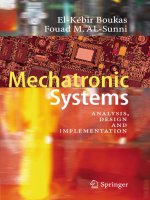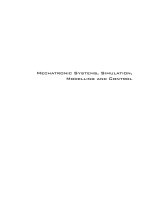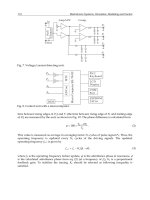Mechatronic systems devices, design, control, operation and monitoring
Bạn đang xem bản rút gọn của tài liệu. Xem và tải ngay bản đầy đủ của tài liệu tại đây (18.71 MB, 492 trang )
Mechatronic
Systems
Devices, Design,
Control, Operation
and Monitoring
0775_C000.fm Page i Tuesday, September 11, 2007 5:11 PM
Mechanical Engineering Series
Frank Kreith & Roop Mahajan - Series Editors
Published Titles
Computer Techniques in Vibration
Clarence W. de Silva
Distributed Generation: The Power Paradigm for the New Millennium
Anne-Marie Borbely & Jan F. Kreider
Elastoplasticity Theory
Vlado A. Lubarda
Energy Audit of Building Systems: An Engineering Approach
Moncef Krarti
Energy Converstion
D. Yogi Goswami and Frank Kreith
Energy Management and Conservation Handbook
Frank Kreith and D. Yogi Goswami
Finite Element Method Using MATLAB, 2
nd
Edition
Young W. Kwon & Hyochoong Bang
Fluid Power Circuits and Controls: Fundamentals and Applications
John S. Cundiff
Fundamentals of Environmental Discharge Modeling
Lorin R. Davis
Handbook of Energy Efficiency and Renewable Energy
Frank Kreith and D. Yogi Goswami
Heat Transfer in Single and Multiphase Systems
Greg F. Naterer
Introductory Finite Element Method
Chandrakant S. Desai & Tribikram Kundu
Intelligent Transportation Systems: New Principles and Architectures
Sumit Ghosh & Tony Lee
Machine Elements: Life and Design
Boris M. Klebanov, David M. Barlam, and Frederic E. Nystrom
Mathematical & Physical Modeling of Materials Processing Operations
Olusegun Johnson Ilegbusi, Manabu Iguchi & Walter E. Wahnsiedler
Mechanics of Composite Materials
Autar K. Kaw
Mechanics of Fatigue
Vladimir V. Bolotin
Mechanism Design: Enumeration of Kinematic Structures According
to Function
Lung-Wen Tsai
Mechatronic Systems: Devices, Design, Control, Operation and Monitoring
Clarence W. de Silva
MEMS: Applications
Mohamed Gad-el-Hak
MEMS: Design and Fabrication
Mohamed Gad-el-Hak
The MEMS Handbook, Second Edition
Mohamed Gad-el-Hak
0775_C000.fm Page ii Tuesday, September 11, 2007 5:11 PM
MEMS: Introduction and Fundamentals
Mohamed Gad-el-Hak
Multiphase Flow Handbook
Clayton T. Crowe
Nanotechnology: Understanding Small Systems
Ben Rogers, Sumita Pennathur, and Jesse Adams
Optomechatronics: Fusion of Optical and Mechatronic Engineering
Hyungsuck Cho
Practical Inverse Analysis in Engineering
David M. Trujillo & Henry R. Busby
Pressure Vessels: Design and Practice
Somnath Chattopadhyay
Principles of Solid Mechanics
Rowland Richards, Jr.
Thermodynamics for Engineers
Kau-Fui Wong
Vibration Damping, Control, and Design
Clarence W. de Silva
Vibration and Shock Handbook
Clarence W. de Silva
Viscoelastic Solids
Roderic S. Lakes
0775_C000.fm Page iii Tuesday, September 11, 2007 5:11 PM
0775_C000.fm Page iv Tuesday, September 11, 2007 5:11 PM
Mechatronic
Systems
Devices, Design,
Control, Operation
and Monitoring
Edited by
Clarence W. de Silva
CRC Press is an imprint of the
Taylor & Francis Group, an informa business
Boca Raton London New York
0775_C000.fm Page v Tuesday, September 11, 2007 5:11 PM
CRC Press
Taylor & Francis Group
6000 Broken Sound Parkway NW, Suite 300
Boca Raton, FL 33487-2742
© 2008 by Taylor & Francis Group, LLC
CRC Press is an imprint of Taylor & Francis Group, an Informa business
No claim to original U.S. Government works
Printed in the United States of America on acid-free paper
10 9 8 7 6 5 4 3 2 1
International Standard Book Number-13: 978-0-8493-0775-1 (Hardcover)
is book contains information obtained from authentic and highly regarded sources. Reprinted material is quoted
with permission, and sources are indicated. A wide variety of references are listed. Reasonable efforts have been made to
publish reliable data and information, but the author and the publisher cannot assume responsibility for the validity of
all materials or for the consequences of their use.
No part of this book may be reprinted, reproduced, transmitted, or utilized in any form by any electronic, mechanical, or
other means, now known or hereafter invented, including photocopying, microfilming, and recording, or in any informa-
tion storage or retrieval system, without written permission from the publishers.
For permission to photocopy or use material electronically from this work, please access www.copyright.com (http://
www.copyright.com/) or contact the Copyright Clearance Center, Inc. (CCC) 222 Rosewood Drive, Danvers, MA 01923,
978-750-8400. CCC is a not-for-profit organization that provides licenses and registration for a variety of users. For orga-
nizations that have been granted a photocopy license by the CCC, a separate system of payment has been arranged.
Trademark Notice: Product or corporate names may be trademarks or registered trademarks, and are used only for
identification and explanation without intent to infringe.
Library of Congress Cataloging-in-Publication Data
Mechatronic systems : devices, design, control, operation and monitoring / Clarence W. de Silva, ed.
p. cm. (Mechanical engineering series)
Includes bibliographical references and index.
ISBN 978-0-8493-0775-1 (alk. paper)
1. Mechatronics. I. Silva, Clarence W. de. II. Title. III. Series.
TJ163.12.M4113 2008
621 dc22 2007017632
Visit the Taylor & Francis Web site at
and the CRC Press Web site at
0775_C000.fm Page vi Tuesday, September 11, 2007 5:11 PM
vii
Dedication
To my friends at the National University of Singapore (alphabetically):
Associate Professor Marcello Ang; Professor Ben M. Chen; Professor Tong Heng Lee;
Professor Jim A.N. Poo; and Associate Professor Kok Kiong Tan.
For valuable support and professional collaboration.
0775_C000.fm Page vii Tuesday, September 11, 2007 5:11 PM
0775_C000.fm Page viii Tuesday, September 11, 2007 5:11 PM
ix
Table of Contents
1
Technology Needs for Mechatronic Systems
C.W. de Silva
1
-
1
Section I Mechatronic Devices
2
Robotic Application of Mechatronics
H. Li and S.X. Yang
2
-
1
3
Swiss Lever Escapement Mechanism
Y. Fu and R. Du
3
-
1
4
Instrumented Wheel for Wheelchair Propulsion Analysis
M. Mallakzadeh and F. Sassani
4
-
1
5
MEMS-Based Ultrasonic Devices
T. Siu and M. Chiao
5
-
1
6
Polyaniline Nanostructures
H. Xia and H.S.O. Chan
6
-1
Section II Communication Technologies
7
TCP Connectivity Analysis in Mobile Ad Hoc Networks
S. Adibi
7-
1
8
i.LIGHT: Communication Using Visible Light
G.K.H. Pang
8
-1
0775_C000.fm Page ix Tuesday, September 11, 2007 5:11 PM
x
9
Bluetooth Networking
V.C.M. Leung and V.W.S. Wong
9
-1
10
Brain–Machine Interfacing and Motor Prosthetics
A.E. Brockwell and M. Velliste
10
-1
Section III Control Technologies
11
Adaptive Control of a Gantry System
C.S. Teo, K.K. Tan, S. Huang and S.Y. Lim
11
-1
12
Virtual Computer Numerical Control System
K. Erkorkmaz, Y. Altintas and C H. Yeung
12
-1
13
Model Predictive Control of a Flexible Robot
T. Fan and C.W. de Silva
13
-1
14
Computer Vision in Multi-Robot Cooperative Control
Y. Wang and C.W. de Silva
14
-1
15
Robotic Tasks Using Discrete Event Controller
N.W. Koh, M.H. Ang Jr. and S.Y. Lim
15
-1
16
Fuzzy Modeling and Control
Z. Guo, J. Mao, Y. Yue and Y. Li
16
-1
Section IV Mechatronic Design and Optimization
17
Mechatronic Modeling and Design
S. Behbahani and C.W. de Silva
17-
1
18
Evolutionary Mechatronic Tool
S. Behbahani and C.W. de Silva
18-
1
0775_C000.fm Page x Tuesday, September 11, 2007 5:11 PM
xi
19
Mechatronic Design Quotient (MDQ)
S. Behbahani and C.W. de Silva
19-
1
20
Kinematic Design Optimization of Acrobot
L. Yang, C.M. Chew, A.N. Poo and C.W. de Silva
20-
1
21
Evolutionary Optimization in the Design of a Heat Sink
M.R. Alrasheed, C.W. de Silva and M.S. Gadala
21-
1
22
Actuator Optimization and Fuzzy Control in Mechatronics
H. Marzi
22-
1
Section V Monitoring and Diagnosis
23
Health Monitoring of a Mechatronic System
F. Pirmoradi, F. Sassani and C.W. de Silva
23-
1
24
Defect Detection of Patterned Objects
H.Y.T. Ngan and G.K.H. Pang
24-
1
25
Fault Detection and Diagnosis in Mechatronic Systems
K.K. Tan, S. Huang, T.H. Lee, A.S. Putra, C.S. Teo and C.W. de Silva
25-
1
26
Sensor Fusion for Online Tool Condition Monitoring
W.H. Wang, Y.S. Wong and G.S. Hong
26-
1
27
Modeling of Cutting Forces During Machining
Z.G. Wang, M. Rahman, Y.S. Wong, K.S Neo, J. Sun and H. Onozuka
27-
1
28
Mechatronics in Landmine Detection and Removal
T. Nanayakkara
,
L. Piyathilaka and A. Subasinghe
28-
1
29
Online Monitoring and Fault Diagnosis of Ship Propulsion Systems
Z. Feng, Z. Chen and Y. Wang
29-
1
Index
I
-
1
0775_C000.fm Page xi Tuesday, September 11, 2007 5:11 PM
0775_C000.fm Page xii Tuesday, September 11, 2007 5:11 PM
xiii
Foreword
The multidisciplinary field of mechatronics brings together mechanical engineering, electrical and elec-
tronic engineering, control engineering, and computer science in a synergistic manner. In recent years,
this field has advanced rapidly and gained maturity, through the development of an increasing number
of degree programs, extensive research activity, product and system developments, and an increasingly
broad range of industrial applications. Above all, as is the case at my own university, both undergraduate-
and graduate-level degree programs are gaining acceptance and are in great demand worldwide. With
this background, I am honored to have been invited to write this foreword for the book
Mechatronic
Systems—Devices, Design, Control, Operation, and Monitoring
, edited by Professor Clarence de Silva. This
volume brings together distinguished scholars and researchers from several disciplines, institutions, and
countries, with the intent of advancing technical knowledge in the theory, design, development, and
application in the field of mechatronics.
The origins of this book may be traced back to a special partnership between the National University
of Singapore (NUS) and the University of British Columbia (UBC) through the NUS-UBC Applied
Science Research Centre. The centre was established in August 2004 as a research partnership between
the Faculty of Applied Science at UBC and our colleagues at NUS. The centre (see www.researchcentre.
apsc.ubc.ca) was formed with the primary goals of initiating, encouraging, facilitating, and fostering
research collaborations between NUS and UBC in the areas of engineering and applied science. In October
2005, the Centre was the primary sponsor of the
International Symposium on Collaborative Research in
Applied Science
that was held at UBC, with Professor de Silva as the symposium chair. The symposium
was well attended, generated much enthusiasm, and sparked lively debate. Most papers of the symposium
were in the area of mechatronics. A selected group of authors among the symposium’s participants and
other prominent researchers in mechatronics were invited to contribute chapters to the present book.
As dean of the Faculty of Applied Science at UBC, I am proud of my university’s association with the
publication of this valuable book. I have no doubt that it will lead to further insights, new research,
enhanced collaborations, and increased practical applications in the field of mechatronics, and will
thereby prove to be of significant benefit to a broad range of researchers, institutions, and industries,
and thus ultimately to society at large.
Professor Michael Isaacson, Ph.D., P.Eng.
Dean, Faculty of Applied Science
The University of British Columbia
0775_C000.fm Page xiii Tuesday, September 11, 2007 5:11 PM
0775_C000.fm Page xiv Tuesday, September 11, 2007 5:11 PM
xv
Preface
With individual chapters authored by distinguished professionals in their respective topics, this book
provides for engineers, designers, researchers, educators, and students, a convenient and up-to-date
reference with information on mechatronic devices and systems, including technologies and method-
ologies for their analysis, design, control, monitoring, and diagnosis. The book consists of 29 chapters,
grouped into 5 sections: mechatronic devices, communication technologies, control technologies,
mechatronic design and optimization, and monitoring and diagnosis. Cross-referencing is used
throughout to indicate other places in the book where further information on a particular topic is
provided.
In the book, equal emphasis is given to theory and practical application. The chapters are grouped
into those covering mechatronic devices and applications, linking and communication within and outside
a mechatronic systems, control of mechatronic systems, design of mechatronic devices and systems, and
monitoring and fault diagnosis of mechatronic systems. Analytical formulations, numerical methods,
design approaches, control techniques, and commercial tools are presented and illustrated using examples
and case studies. Practical implementations, field applications, and experimentation are described and
demonstrated.
Mechatronics concerns synergistic and concurrent use of mechanics, electronics, computer engineer-
ing, and intelligent control systems in modeling, analyzing, designing, developing, and implementing
smart electromechanical products. As the modern machinery and electromechanical devices are typically
being controlled using analog and digital electronics and computers, the technologies of mechanical
engineering in such a system can no longer be isolated from those of electronic and computer engi-
neering. For example, in a robot systems or a micro-machine, mechanical components are integrated
with analog and digital electronic components to provide single functional units or products. Similarly,
devices with embedded and integrated sensing, actuation, signal processing, and control have many
practical advantages. In the framework of mechatronics, a unified approach is taken to integrate different
types of components and functions, both mechanical and electrical, in modeling, analysis, design, and
implementation, with the objective of harmonious operation that meets a desired set of performance
specifications.
In the mechatronic approach, a multidomain (mixed) system consisting of subsystems that have
primarily mechanical (including fluid and thermal) or primarily electrical (including electronic) char-
acter is treated using integrated engineering concepts. In particular, electromechanical analogies, consis-
tent energy transfer (e.g., kinetic, potential, thermal, fluid, electrostatic, and electromagnetic energies)
through energy ports and integrated design methodologies may be incorporated, resulting in benefits
with regard to performance, efficiency, reliability, and cost.
0775_C000.fm Page xv Tuesday, September 11, 2007 5:11 PM
xvi
Mechatronics has emerged as a bona fide field of practice, research, and development, and simulta-
neously as an academic discipline in engineering. The present book is geared toward the focus on
integrated education and practice as related to electromechanical and multidomain systems. In view of
the analytical methods, practical considerations, design issues, and experimental techniques that are
presented throughout the book, it serves as a useful reference tool and an extensive information source
for engineers in industry and laboratories, researchers, and students in the field of mechatronics.
Clarence W. de Silva
Vancouver
0775_C000.fm Page xvi Tuesday, September 11, 2007 5:11 PM
xvii
Acknowledgments
I wish to express my gratitude to the authors of the chapters for their valuable and highly professional
contributions. The assistance of my research associate and lab manager, Ying Wang, in managing the manu-
script production was quite valuable. I am very grateful to Michael Slaughter, executive editor–engineering,
CRC Press, for his enthusiasm and support throughout the project. The editorial and production staff
at CRC Press and its affiliates, particularly Jim McGovern, Robin Lafazan, and John Lavender have done
an excellent job in getting the book out in print. It is with much sadness that I note here the tragic loss
of Liz Spangenberger of CRC Press, who had eagerly helped me with the publication of many of my
books. Finally, I wish to lovingly acknowledge the patience and understanding of my family.
0775_C000.fm Page xvii Tuesday, September 11, 2007 5:11 PM
0775_C000.fm Page xviii Tuesday, September 11, 2007 5:11 PM
xix
The Editor
Clarence W. de Silva
, P.Eng., Fellow ASME and Fellow IEEE, is Professor of Mechanical Engineering,
University of British Columbia, Vancouver, Canada, and has occupied the NSERC Research Chair in
Industrial Automation since 1988. Prior to that he served as a faculty member at Carnegie Mellon
University (1978–1987) and as a Fulbright Visiting Professor at the University of Cambridge (1987–1988).
De Silva has earned Ph.D. degrees from the Massachusetts Institute of Technology (1978) and Cambridge
University, England (1998). De Silva has also occupied the Mobil Endowed Chair Professorship in the
Department of Electrical and Computer Engineering at the National University of Singapore (2000). He
has served as a consultant to several companies including IBM and Westinghouse in the United States,
and has led the development of six industrial machines. He is recipient of the Henry M. Paynter
Outstanding Investigator Award and Yasundo Takahashi Education Award of the Dynamic Systems and
Control Division of the American Society of Mechanical Engineers (ASME); Killam Research Prize;
Outstanding Engineering Educator Award of IEEE Canada; Lifetime Achievement Award of the World
Automation Congress; IEEE Third Millennium Medal; Meritorious Achievement Award of the Association
of Professional Engineers of British Columbia; and the Outstanding Contribution Award of the Systems,
Man, and Cybernetics Society of the Institute of Electrical and Electronics Engineers (IEEE). He has
authored 16 technical books including
Sensors and Actuators—Control System Instrumentation
(Taylor &
Francis/CRC Press, 2007);
Vibration: Fundamentals and Practice
, Second Edition (Taylor & Francis/CRC
Press, 2006);
Mechatronics—An Integrated Approach
(Taylor & Francis/CRC Press, 2005);
Soft Computing
and Intelligent Systems Design—Theory, Tools, and Applications
(with F. Karry, Addison-Wesley, 2004);
Intelligent Control: Fuzzy Logic Applications
(CRC Press, 1995);
Control Sensors and Actuators (Prentice
Hall, 1989); over 170 journal papers; and a similar number of conference papers and book chapters. He
has served as editor of twelve books and on the editorial boards of twelve international journals. He is
the Editor-in-Chief, of International Journal of Control and Intelligent Systems; and was Editor-in-Chief,
International Journal of Knowledge-Based Intelligent Engineering Systems; Senior Technical Editor, Mea-
surements and Control; and Regional Editor, North America, Engineering Applications of Artificial
Intelligence—the International Journal of Intelligent Real-Time Automation. He is a Lilly Fellow, NASA-
ASEE Fellow, Senior Fulbright Fellow at Cambridge University, Fellow of the Advanced Systems
Institute of British Columbia, Killam Fellow, and Fellow of the Canadian Academy of Engineering.
0775_C000.fm Page xix Tuesday, September 11, 2007 5:11 PM
0775_C000.fm Page xx Tuesday, September 11, 2007 5:11 PM
xxi
Contributors
S. Adibi
University of Waterloo
Waterloo, Ontario
Canada
M.R. Alrasheed
University of British Columbia
Vancouver, British Columbia
Canada
Y. Altintas
University of British Columbia
Vancouver, British Columbia
Canada
M.H. Ang, Jr.
National University of Singapore
Singapore
S. Behbahani
University of British Columbia
Vancouver, British Columbia
Canada
A.E. Brockwell
Carnegie Mellon University
Pittsburgh, Pennsylvania
H.S.O. Chan
National University of Singapore
Singapore
Z. Chen
Ningbo University
Ningbo, Zhejiang
China
C.M. Chew
National University of Singapore
Singapore
M. Chiao
University of British Columbia
Vancouver, British Columbia
Canada
C.W. de Silva
University of British Columbia
Vancouver, British Columbia
Canada
R. Du
The Chinese University
of Hong Kong
Hong Kong
K. Erkorkmaz
University of Waterloo
Waterloo, Ontario
Canada
T. Fan
The University of British Columbia
Vancouver, British Columbia
Canada
Z. Feng
Ningbo University
Ningbo, Zhejiang
China
Y. Fu
The Chinese University
of Hong Kong
Hong Kong
M.S. Gadala
University of British Columbia
Vancouver, British Columbia
Canada
Z. Guo
Beijing University of Aeronautics
and Astronautics
Beijing, China
G.S. Hong
National University of Singapore
Singapore
S. Huang
National University of Singapore
Singapore
N.W. Koh
National University of Singapore
Singapore
T.H. Lee
National University of Singapore
Singapore
V.C.M. Leung
University of British Columbia
Vancouver, British Columbia
Canada
H. Li
University of Guelph
Guelph, Ontario
Canada
Y. Li
Beijing University of Aeronautics
and Astronautics
Beijing, China
S.Y. Lim
Singapore Institute of
Manufacturing Technology
Singapore
M. Mallakzadeh
University of British Columbia
Vancouver, British Columbia
Canada
0775_C000.fm Page xxi Tuesday, September 11, 2007 5:11 PM
xxii
J. Mao
Beijing University of Aeronautics
and Astronautics
Beijing, China
H. Marzi
St. Francis Xavier University
Antigonish, Nova Scotia
Canada
T. Nanayakkara
University of Moratuwa
Sri Lanka
K.S. Neo
National University of Singapore
Singapore
H.Y.T. Ngan
University of Hong Kong
Hong Kong
H. Onozuka
National University
of Singapore
Singapore
G.K.H. Pang
University of Hong Kong
Hong Kong
F. Pirmoradi
University of British Columbia
Vancouver, British Columbia
Canada
L. Piyathilaka
Rinzen Laboratories
Sri Lanka
A.N. Poo
National University
of Singapore
Singapore
A.S. Putra
National University of Singapore
Singapore
M. Rahman
National University of Singapore
Singapore
F. Sassani
University of British Columbia
Vancouver, British Columbia
Canada
T. Siu
University of British Columbia
Vancouver, British Columbia
Canada
A. Subasinghe
Rinzen Laboratories
Sri Lanka
J. Sun
National University of Singapore
Singapore
K.K. Tan
National University of Singapore
Singapore
C.S. Teo
National University of Singapore
Singapore
M. Velliste
University of Pittsburgh
Pittsburgh, Pennsylvania
W.H. Wang
National University of Singapore
Singapore
Y. Wang
University of British Columbia
Vancouver, British Columbia
Canada
Z.G. Wang
National University
of Singapore
Singapore
V.W.S. Wong
University of British Columbia
Vancouver, British Columbia
Canada
Y.S. Wong
National University
of Singapore
Singapore
H. Xia
National University
of Singapore
Singapore
L. Yang
National University
of Singapore
Singapore
S.X. Yang
University of Guelph
Guelph, Ontario
Canada
C.H. Yeung
University of British Columbia
Vancouver, British Columbia
Canada
Y. Yue
Beijing University of Aeronautics
and Astronautics
Beijing, China
0775_C000.fm Page xxii Tuesday, September 11, 2007 5:11 PM
1
-1
1
Technology Needs for
Mechatronic Systems
1.1 Introduction
1-
1
1.2 Mechatronic System Technologies
1-
2
1.3 Intelligent Mechatronic Devices
1-
4
1.4 Modeling and Design
1-
6
1.5 Mechatronic Design Concept
1-
7
Mechatronic Design Quotient (MDQ)
1.6 Evolution of Mechatronics
1-
9
1.7 Application Areas
1-
10
1.8 Conclusion
1-
11
References
1-
11
Summary
Mechatronics is a multidisciplinary engineering field which involves a synergistic integration of several areas
such as mechanical engineering, electrical and electronic engineering, control engineering, and computer
engineering. In this chapter the field of mechatronics is introduced, the technology needs for such systems
are indicated, and some important issues in the design and development of a mechatronic product or system
are highlighted. Technologies of sensing, actuation, signal conditioning, interfacing, communication, and
control are particularly important for mechatronic systems. Intelligent mechatronic systems require further
technologies for representation and processing of knowledge and intelligence, and particularly those tech-
nologies that impart intelligent characteristics to the system. The design and development of a mechatronic
system will require an integrated and concurrent approach to deal with the subsystems and subprocesses
of a multidomain (mixed) system. The subsystems of a mechatronic system should not be designed or
developed independently without addressing the system integration, subsystem interactions and matching,
and the intended operation of the overall system. Such an integrated and concurrent approach will make
a mechatronic design more optimal than a conventional design. In this chapter, some important issues in
the design and development of a mechatronic product or system are highlighted.
1.1 Introduction
The subject of mechatronics concerns the synergistic application of mechanics, electronics, controls, and
computer engineering in the development of electromechanical products and systems, through an integrated
design approach [1]. A mechatronic system will require a multidisciplinary approach for its design, devel-
opment, and implementation. In the traditional development of an electromechanical system, the mechan-
ical components and electrical components are designed or selected separately and then integrated, possibly
C.W. de Silva
0775_C001.fm Page 1 Tuesday, September 4, 2007 9:17 AM
1
-2
Mechatronic Systems: Devices, Design, Control, Operation and Monitoring
with other components, and hardware and software. In contrast, in the mechatronic approach, the entire
electromechanical system is treated concurrently in an integrated manner by a multidisciplinary team of
engineers and other professionals. Naturally, a system formed by interconnecting a set of independently
designed and manufactured components will not provide the same level of performance as a mechatronic
system, which employs an integrated and concurrent approach for design, development, and implementa-
tion [2]. The main reason is straightforward. The best match and compatibility between component
functions can be achieved through an integrated and unified approach to design and development, and
best operation is possible through an integrated implementation. Generally, a mechatronic product will be
more efficient and cost effective, more precise and accurate, more reliable, more flexible and functional,
and less mechanically complex, compared to a nonmechatronic product that needs a similar level of effort
in its development. Performance of a nonmechatronic system can be improved through sophisticated
control, but this is achieved at an additional cost of sensors, instrumentation, and control hardware and
software, and with added complexity and control burden. Mechatronic products and systems include
modern automobiles and aircraft, smart household appliances, medical robots, space vehicles, and office
automation devices. In this chapter, some important issues in the design and development of a mechatronic
product or system will be highlighted and the associated technology needs will be indicated.
1.2
Mechatronic System Technologies
A typical mechatronic system consists of a mechanical skeleton, actuators, sensors, controllers, signal
conditioning/modification devices, computer/digital hardware and software, interface devices, and power
sources. Different types of sensing, and information acquisition and transfer are involved among all these
various types of components. For example, a servomotor, which is a motor with the capability of sensory
feedback for accurate generation of complex motions, consists of mechanical, electrical, and electronic
components (see Figure 1.1). The main mechanical components are the rotor and the stator. The electrical
components include the circuitry for the field windings and rotor windings (not in the case of permanent-
magnet rotors, as shown in Figure 1.1), and circuitry for power transmission and commutation (if needed).
Electronic components include those needed for sensing, (e.g., optical encoder for displacement and speed
sensing, and tachometer for speed sensing) [3].
FIGURE 1.1
Brushless dc servomotor is a mechatronic device.
Microelectronic
Drive Circuit
(Stator Switching)
DC Power
Supply
Pulse
Generator
Angular
Position
Sensor
S
Pole
Rotor
Poles
Stator
Windings
Speed
Setting
Timed Pulses
(Switching Commands)
Power to
Stator Segments
×
×
×
×
×
(Optical Encoder)
×
σ
m
N
Pole
0775_C001.fm Page 2 Tuesday, September 4, 2007 9:17 AM









